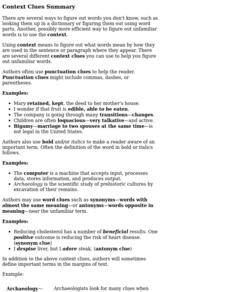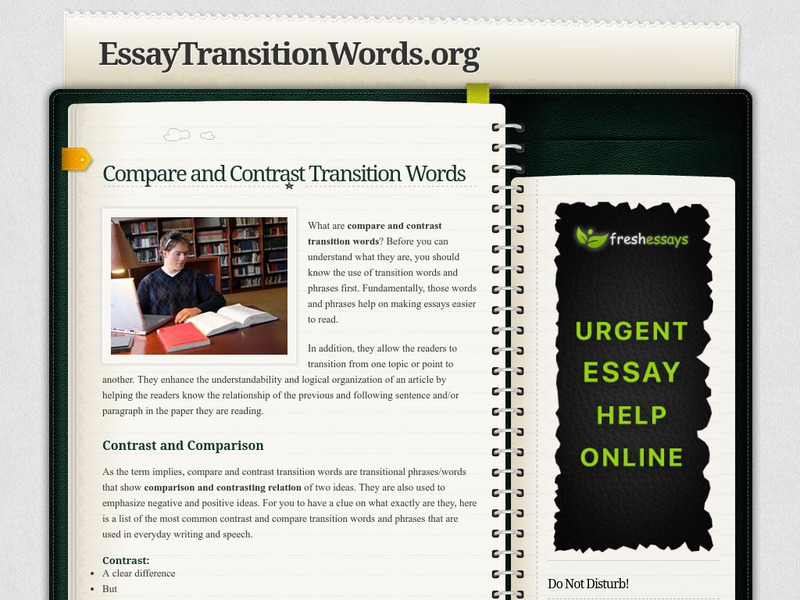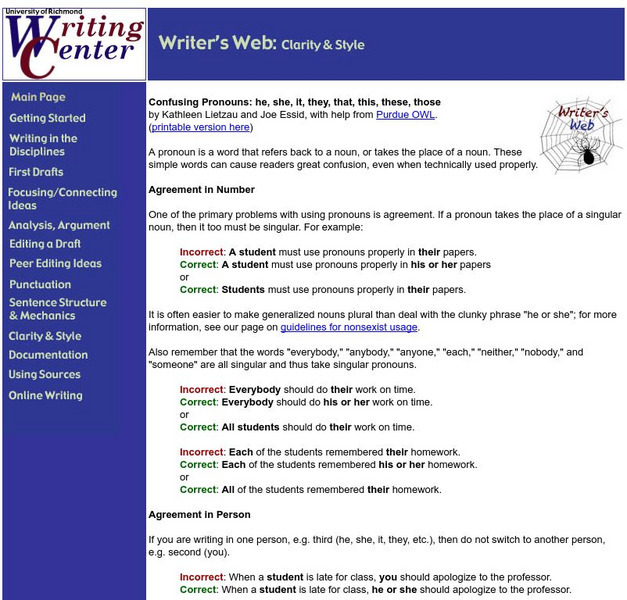Savvas Learning
Pearson Education: Longman Vocabulary Website: Using Context Clues: Word Clues
This site offers a review of using context clues, along with three progressively more difficult practice exercises. Students match the highlighted word in the sentence with its meaning using a pull down box. In the third exercise, the...
Vocabulary University
My vocabulary.com: Word Roots Lesson 5: Nat Tract Sequ: Word Roots #5 Beginner
This lesson plan features the Latin roots NAT = be born; TRACT = pull, draw; SEQU/SECU = follow. Choose 1 of the 8 different word puzzle activities from the list below. Each word puzzle will have directions, a clue, and a vocabulary word...
Vocabulary University
My vocabulary.com: Word Roots Lesson 7: Spect Sta Vert: Word Roots #7 Beginner
This lesson plan features the Latin roots SPECT/SPEC = watch, see, look, appear; STA/SIST = stand, place; VERT/VERS = turn. Choose 1 of the 8 different word puzzle activities from the list below. Each word puzzle will have directions, a...
Vocabulary University
My vocabulary.com: Word Roots Lesson 8: Sent Grat Pon: Word Roots #8 Beginner
This lesson plan features the Latin roots SENT-SENS = feel, be aware, think; GRAT-GRAC-GREE = thankful, pleasing; PON-POS = place, put Choose 1 of the 8 different word puzzle activities from the list below. Each word puzzle will have...
Vocabulary University
My vocabulary.com: Word Roots Lesson 9: Clud Dit Fid: Word Roots #9 Beginner
This lesson plan features the Latin roots CLUD-CLUS-CLOS = close, shut; DIT-DO = give, push; FID = faith, trust. Choose 1 of the 8 different word puzzle activities from the list below.Each word puzzle will have directions, a clue and a...
Wisconsin Response to Intervention Center
Wisconsin Rt I Center: Contextual Redefinition [Pdf]
Classroom teachers will learn about contextual redefinitions, an engaging instructional strategy. Teachers will learn how to implement the strategy, understand how to measure progress with contextual redefinitions, find research that...
Other
Descriptive Writing Technique
Different techniques for writing detailed descriptions of an object are found on this page.
ReadWriteThink
Read Write Think: Character Clash: A Mini Lesson on Paragraphing and Dialogue
Contains plans for a minilesson that teaches about proper dialogue format while writing, specifically paragraphing. In addition to objectives and standards, this instructional plan contains links to sites used in the lessons as well as...
University of Richmond
University of Richmond: Transitional Words and Phrases
This site has a list of transitional words and phrases organized by their function in a sentence or paragraph. Because they are organized under such headings as "providing an example" and "showing conclusions," it is easy to find an...
ReadWriteThink
Read Write Think: Writing Alternative Plots for Robert O'brien's Z for Zachariah
Lesson in which students are required to write an alternative plot to O'Brien's science fiction novel. Includes an interactive graphic organizer, handouts, and a rubric.
Houghton Mifflin Harcourt
Holt, Rinehart and Winston: Using Transitional Expressions [Pdf]
Practice tying your sentences and ideas together with this worksheet on transitional expressions. W.9-10.1c cohesion/clarity/reason
Writing Fix
Writing Fix: Rolling With the Animals
After reading Duck on a Bike by David Shannon, the writer will plan an original story where an animal (other than a duck) finds itself in a human mode of transportation (other than a bike). Three other animals will react to the unusual...
Other
Essay Transition Words: Compare and Contrast Transition Words
This reference page focuses on compare and contrast transition words including defining transitions and compare and contrast transitions, providing a list of transition words, and showing how to use transitions in writing essays.
Other
Visual Thesaurus: Shades of Meaning
In this lesson, small groups of students will compete in a "shades of meaning" contest to see which group can use the Visual Thesaurus to help them match words with similar definitions but different connotations in the shortest amount of...
ReadWriteThink
Read Write Think: Finding Figurative Language in the Phantom Tollbooth
Contains plans for four lessons that use The Phantom Tollbooth by Norton Juster to teach about figurative language. In addition to objectives and standards, this instructional plan contains links to handouts and to sites used in the...
Online Writing Lab at Purdue University
Purdue University Owl: Quoting, Paraphrasing, and Summarizing
Provides guidance on the ways to quote, paraphrase, and summarize information. Gives various reasons for paraphrasing, summarizing, and quoting various sources.
ReadWriteThink
Read Write Think: Introducing Each Other: Interviews, Memoirs, Photos, Internet
This lesson plan is designed to teach various methods students can use when researching background information on one another in order to introduce each other in written and oral form.
Capital Community College Foundation
Guide to Grammar and Writing: The Dash
Instructional resource providing notes and examples on the rules for using the dash.
ReadWriteThink
Read Write Think: Developing, Writing, and Evaluating Persuasive Speeches
Contains plans for four lessons that teach learners how to make and present strong persuasive speeches. In addition to objectives and standards, this instructional plan contains links to sites used in the lessons as well as assessment...
Education Development Center
Tune in to Learning: Summarizing
Series of interactive activities for practicing skills in summarizing information, in identifying main points and ideas, and in sorting lists into meaningful categories.
ReadWriteThink
Read Write Think: Guided Comprehension: Summarizing
Lesson that introduces young scholars to the comprehension technique of summarizing. Students learn using the QuIP (questions into paragraphs) method which involves organizing information and putting it in writing.
AdLit
Ad lit.org: Teaching Word Meanings as Concepts
The most effective vocabulary instruction teaches word meanings as concepts; it connects the words being taught with their context and with the students' prior knowledge. Six techniques have proven especially effective: Concept...
Other
Literature Circles Resource Center: Teaching Students How to Discuss
Teachers are given strategies and hands-on approaches to help students prepare for a discussion and participate as active members of it.
University of Richmond
University of Richmond: Confusing Pronouns
This site discusses the need to avoid ambiguous pronoun references. Includes a helpful rewriting examples. Brief, but informative and factual.





![Wisconsin Rt I Center: Contextual Redefinition [Pdf] Professional Doc Wisconsin Rt I Center: Contextual Redefinition [Pdf] Professional Doc](https://d15y2dacu3jp90.cloudfront.net/images/attachment_defaults/resource/large/FPO-knovation.png)
















